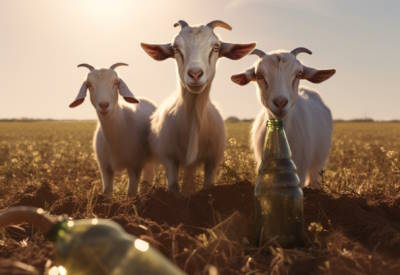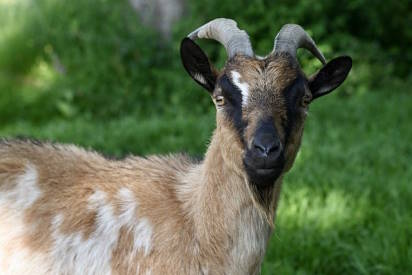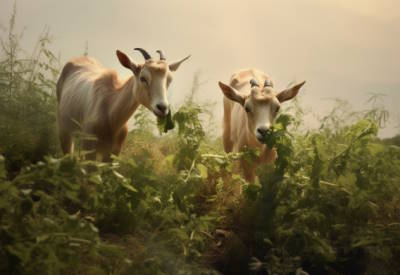Can goats eat plastic? It’s a question that once popped into my mind as I watched my playful goat curiously nibble on a discarded candy wrapper. The answer is simple: No, they shouldn’t. While goats are notoriously curious creatures, often tasting a variety of things in their environment, plastic is neither safe nor suitable for their consumption.
My journey into understanding the relationship between goats and plastic unveiled a tapestry of myths, environmental concerns, and broader ecological implications. Let’s unravel this topic together, starting from misconceptions and diving deep into the repercussions of a world increasingly inundated by plastic.
Common Misconceptions and Goat Anatomy
At the heart of understanding goats and their diets is distinguishing between age-old tales and their actual physiological capabilities. By delving into both the myths surrounding goats and the intricate design of their digestive system, we can get a clearer picture of what truly aligns with their natural consumption habits.
Digging Deeper into Goat Tales and Truths
There’s a fascinating blend of fact and fiction when it comes to what goats eat. Let’s dive into these tales and the actual anatomy of a goat to understand their dietary habits better.
The Mythical Goat Appetite
Goats, those playful and sometimes mischievous creatures, have been the subject of countless myths and tales. One of the most popular sayings you might have heard is that “Goats will eat anything!” It’s a fun phrase that paints a picture of these animals as indiscriminate munchers. But how much truth is there to it?
Understanding the Ruminant System
Within the anatomy of a goat lies a complex ruminant digestive system. This system allows them to process a variety of natural foods, from grasses to shrubs. With four distinct chambers – the rumen, reticulum, omasum, and abomasum – goats are uniquely equipped to digest plant materials. It’s a marvel of nature, but it certainly wasn’t designed for plastic.
[GoatAffiliate]
Understanding Plastic and Why Goats Might Eat It
In a world increasingly littered with plastic waste, the lines between natural food and unnatural pollutants can get blurred for our livestock. For goats, creatures governed by curiosity, plastic objects might seem like a new treat to explore, leading to unintended consequences.
The Unintended Intersection of Goats and Plastic
In our plastic-dominated world, even our livestock aren’t spared from encountering these synthetic materials. Let’s understand why goats, despite their natural diet, might end up nibbling on plastic.
Types and Prevalence of Plastic
When you look at the different types of plastics around – from PET bottles to the HDPE bags – it’s a wonder how they’ve integrated themselves into every facet of our modern lives. Given the prevalence of plastic, especially in waste-ridden areas, it’s not entirely shocking that a curious goat might mistake it for food.
Goat Curiosity: A Double-edged Sword
Goats are naturally inquisitive creatures. They nibble, taste, and explore their environments with their mouths. With plastic waste littering many landscapes, the chances of a goat encountering and trying out a piece of plastic are, unfortunately, quite high. Whether it’s the color, texture, or just plain curiosity, these animals sometimes can’t help but have a taste.
The Consequences of Plastic Ingestion
It’s easy to overlook the aftereffects when a goat nibbles on a piece of plastic, deeming it as a minor incident. However, this seemingly small act can spiral into severe health challenges, both immediate and long-term, for these gentle animals.
The Unseen Impact of a Simple Bite
It might just seem like a curious nibble, but the consequences of a goat ingesting plastic can be far-reaching. Let’s delve into what happens post that bite.
Immediate Physical Complications
Imagine trying to digest something that’s not meant for consumption. For goats, ingesting plastic isn’t just unnatural; it’s dangerous. There’s the very real risk of choking, especially if the plastic piece is large or has sharp edges. Then there’s the nightmare scenario of intestinal blockages, where the plastic gets stuck, leading to pain and potential internal damage.
Long-term Health Concerns
Over time, plastic can introduce toxins into the goat’s system, leading to long-term health issues. And it’s not just hearsay; many farmers and goat owners have relayed distressing stories of their goats suffering after accidentally consuming plastic. These anecdotes serve as sobering reminders of the consequences of plastic pollution.
Prevention and Sustainable Alternatives
As the saying goes, “An ounce of prevention is worth a pound of cure.” Recognizing the threats posed by plastic to our goats and the environment at large, it’s essential to explore measures of prevention, coupled with sustainable alternatives, to pave the way for a safer, greener future.
Guarding Our Goats and Going Green
The challenges are evident, but so are the solutions. Let’s look at how we can protect our goats from plastic and explore sustainable alternatives to create a safer environment.
Prioritizing Safe Grazing Practices
Knowing the risks, it’s vital for anyone raising or caring for goats to prioritize their safety. One of the foremost measures is ensuring safe grazing practices. This might mean routinely inspecting grazing areas for plastic waste or even fencing off areas known for litter. The saying “prevention is better than cure” couldn’t be more relevant here.
Sustainable Shifts and Advocacy
In our modern age, where sustainability is more crucial than ever, seeking biodegradable alternatives to plastic can also be a game-changer. Whether it’s using natural materials in farming or supporting initiatives that promote eco-friendly packaging, every little bit helps. And beyond just our furry goat friends, creating awareness in our communities about the dangers of plastic can lead to broader positive changes.
The Broader Environmental Context
While goats provide a tangible example, the plastic crisis extends well beyond them, touching almost every corner of our ecosystems. By understanding the broader implications of plastic pollution, we can better comprehend the pressing urgency to act and the interconnectedness of all living beings in this global dilemma.
Beyond Goats: Plastic’s Pervasive Problem
The issue of plastic pollution isn’t exclusive to goats. As we take a step back, we realize the broader environmental context in which this problem resides.
The Environmental Chain Reaction
Our environment is bearing the brunt of our plastic consumption. When animals, not just goats, encounter plastic in their habitats, they face many of the same risks. It’s a cycle of harm. Animals ingest plastic, face health complications, and can even pass on microplastics up the food chain.
Humans: The Culprits and the Victims
As top-tier consumers, humans are not exempt from the effects. Our actions, directly and indirectly, play a significant role in shaping the health of our planet and its inhabitants. The story of goats and plastic serves as a stark reminder of this interconnectedness, urging us to act responsibly and thoughtfully.
What Other Items Can Goats Eat Apart from Plastic?
The curiosity of goats often leads them to nibble on various items they encounter. While plastic remains a significant concern, there are several other commonly found items that spark a goat’s interest. Let’s dive into three such items and evaluate if they’re fit for goat consumption.
Cans
While the popular depiction of goats munching on tin cans might be amusing, it’s far from reality. Goats don’t actually eat cans. They might be attracted to the glue on labels or remnants of food on the can, leading them to lick or nibble at it. However, consuming metal or sharp edges can be harmful to goats, causing injuries or digestive problems. So, it’s best to keep cans out of their reach.
Read More: Can Goats Eat Cans? Debunking Myths About Goat Diets
Paper
Ever seen a goat nibbling on a newspaper or cardboard? While paper is not inherently toxic to goats, it shouldn’t form a significant part of their diet. They might occasionally chew on paper out of curiosity or to play, but it offers no nutritional value. If it’s a small amount and not coated with harmful chemicals or inks, occasional consumption might not harm them, but it’s always better to prioritize their regular diet.
Read More: Can Goats Eat Paper? Busting Myths On Their Diet
Copper
Copper is a tricky one. Goats do require copper in their diet, as it plays a vital role in their health, aiding in bone development, hair color, and overall growth. However, it’s all about balance. Too little copper can lead to deficiency, while too much can result in copper toxicity. It’s essential to provide goats with a balanced diet that meets their copper needs without overdoing it. Always consult with a veterinarian or livestock nutritionist to ensure the right copper intake for your goats.
Read More: Can Goats Eat Copper? Debunking Myths & More
Can goats eat plastic – final thoughts
In the great tapestry of goat lore, we’ve tackled the burning question: Can goats eat plastic? Well, while these boisterous beasts may give the impression they’re ready to chow down on everything from your shirt to your shoelaces, plastic is a definite no-go on their menu. Turns out, their belly rumbles aren’t pleas for PET bottles or HDPE bags, but for the lush greens and grains that nature intended.
As we journeyed through myths, dissected goat anatomy, and waded through plastic’s omnipresence, one thing’s crystal clear: Our environment, goats included, would be a lot happier if we turned down the plastic and turned up our sustainable efforts. So next time you see a goat, offer it some tasty hay, not your discarded candy wrapper!






